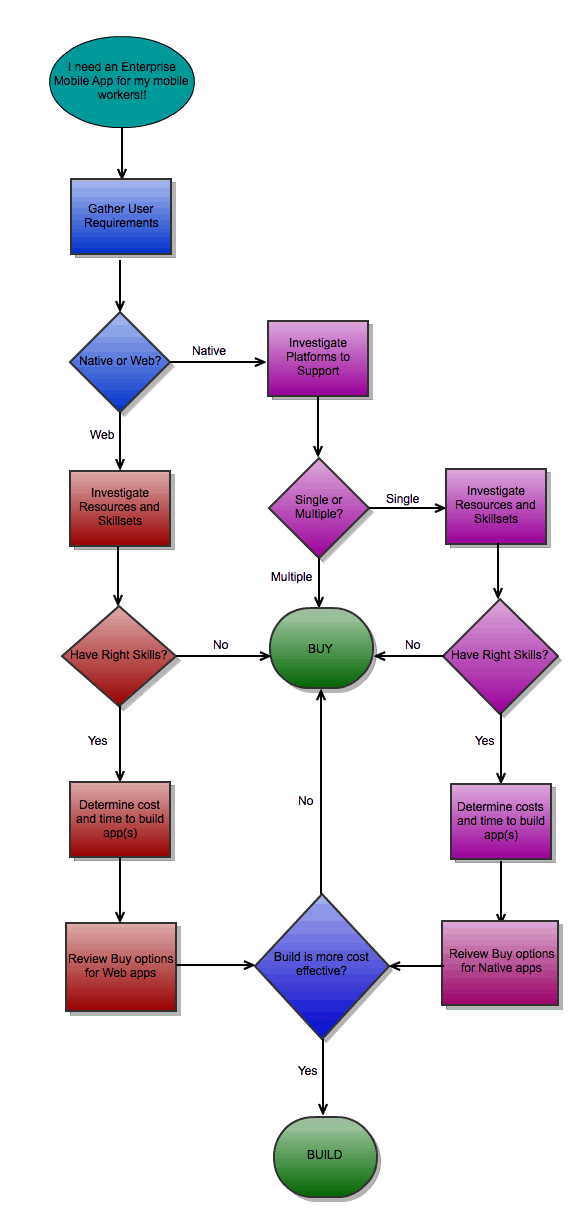09 Apr Enterprise Mobile Apps: Should I Buy or Build?
 So, your mobile workers need access to their business applications while they are working outside the office. Home-office doesn’t do the trick, because your workers are really mobile. Field services, salesforce, traveling project managers, supervisors, IT service engineers, equipment inspectors, etc. You’ve tried a variety of patch-together solutions, but realize that you need enterprise mobile apps that are much more robust and comprehensive.
So, your mobile workers need access to their business applications while they are working outside the office. Home-office doesn’t do the trick, because your workers are really mobile. Field services, salesforce, traveling project managers, supervisors, IT service engineers, equipment inspectors, etc. You’ve tried a variety of patch-together solutions, but realize that you need enterprise mobile apps that are much more robust and comprehensive.
But, how do you do it? It’s the classic buy-vs-build dilemma in software development. Do I buy a product to allow me to get to market quicker, or do I hire software developers to build a custom solution?
And the question isn’t even that black and white because there are so many options available — SaaS (Software as a Service), Open Source, frameworks, and customizable platforms — that blur the lines between buy and build so you can take advantage of the gray area between two extremes, i.e., you can buy a toolset or framework that gets you most of the way there, and then customize it to meet specific requirements.
In terms of enterprise mobile apps, the choice of web-based / HTML5 applications, native applications, and hybrid applications also plays into the mix. You need to think about which mobile platforms you want to support and what tasks you want your mobile end-users to be able to perform on their mobile devices.
Native applications will provide the best user experience and most robust functionality because your software program will have access to all of the capabilities of the device and will be able to operate without connectivity to a web server.
Web-based applications make it easier to support a variety of mobile devices because they run inside a web-browser, which is available on most mobile devices. However, user experience and performance suffer and are highly dependent on connectivity.
Hybrid applications try to find some middle ground by operating as a native, downloadable mobile application that utilizes the web-browser environment to remove the requirement for building a device-specific user interface. All of that is important, because, regardless of whether you buy or build, you really want to know what you’re going to get. If you buy a solution, you want to know if the end result will be native, web-based, or hybrid. You’ll want to know how customizable the solution is, and how to make changes to it in the future. If you build a solution, you need to properly set requirements and understand the limitations and costs of each approach.
Use this buy versus build flowchart to help guide you through the decision-making process on deploying cross-platform enterprise mobile applications.
Enterprise Mobile Apps: Buy Versus Build Decision Tree

- Don’t make the mistake of predicating your decision about HTML/Web-based versus Native apps on the cost of development! In both cases, there is significant development cost and time as well as maintenance over time. The decision of Web vs. Native should be made strictly on user requirements, considering performance, security, user experience, device feature usage, and offline capability.
- Understanding that the enterprise mobility arena is very complex and fractured, make sure to think about what you’ll want and need in the future and make sure your approach is flexible enough to scale and change along with your ongoing business needs.
Finally, if your analysis leads you to a “Buy or Build Native” answer, we encourage you to investigate Mobile Reach solutions. We strive to provide an environment for you to rapidly build and own robust, task-focused, cross-platform, native applications giving you an excellent user experience while eliminating the biggest challenge (time-to-market) of the process.



